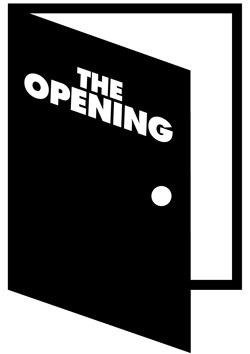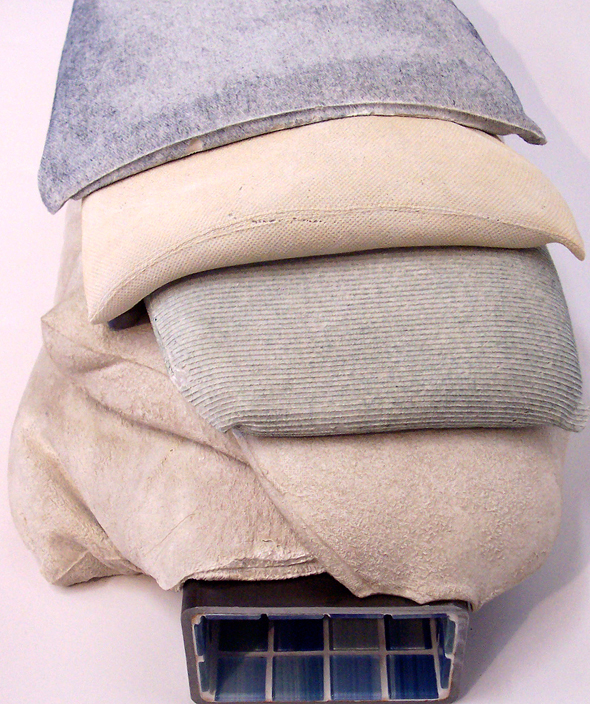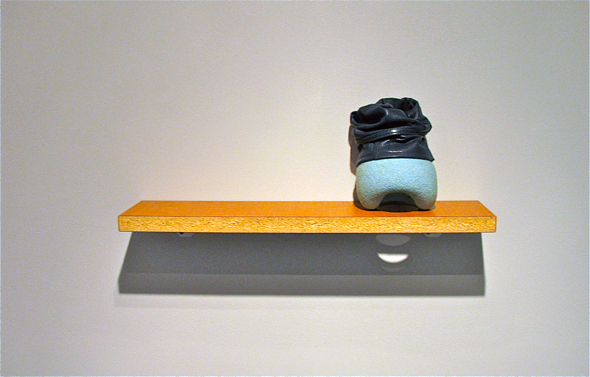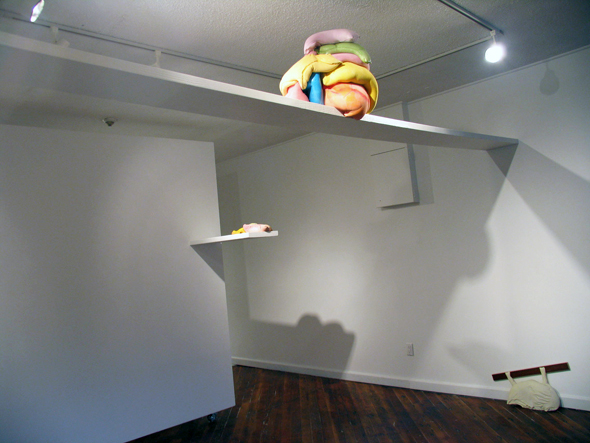
|
THE OPENING is all about introducing the fascinating, quirky and wonderful people working in and around the visual arts in Vancouver. Each week, we'll feature an artist, collective, curator or administrator to delve deep into who and what makes art happen! |
Jasmine Reimer (b. 1981) is interested in the things we are excessive about. Her colourful and whimsical figures reference the body and how we deal with our different shapes, using plaster poured in fabric to create slumpy, bumpy shapes, textured like fabric. We met over tea recently on a very soggy afternoon.

Slip (detail)
What are you doing at the Vytlacil Artist Residency in New York?
It’s self-directed, so there’s no theme. They are affiliated with this college in Manhattan called the Art Students League. It’s kind of cool in a way because the college is a non-degree granting, non-diploma granting college that’s been around since the late 1800s. Professional artists can go and take classes in whenever they want. And it’s cheap! The list of people who have been there like Robert Rauschenberg is amazing. Luckily they gave me a half scholarship, so I only have to pay for half the residency. And then they gave me money to take a class.
So what are you going to take?
I’m going to take bronze-casting. I didn’t get to do it at Emily Carr because the foundry was always down, so I’m going to learn to make bronze things.
That would be a sort of different direction from where you’re going right now.
Well, kind of. It’s just a technique that I want to have under my belt. I kind of feel that the next few years for me are going to be grasping skills, a bunch of skills, that I can kind of put in my pocket and draw out or combine. I think my work will always kind of be the way that I make it.

Easy 2
It’s just interesting because plaster is such a, almost a rudimentary type of material to use, and a lot of artists seem to move on to something like bronze once they have the ability to do so. Do you feel that way?
No… I understand that, but I don’t look at plaster that way because I’ve been using it for so long because I liked what I could do with it. It’s so controllable. I think I might have a problem with something like bronze-casting that’s going to fight back a lot more. I’ve been looking at lots of bronze sculpture just to see what other artists have been doing with it. They’re really messing around with it. I was worried, I thought, I don’t want to go into such a traditional territory. But people are really f*cking it up. It’s really cool. Plus I’m interested in working in a public area in my future. I would like to have knowledge of permanent materials. Plaster is so not permanent.
Yeah in this weather it wouldn’t last…
It would dissolve in 20 minutes!

Pile in progress
A lot of your work is about excess. What about excess interests you?
It’s the pattern of excess that interests me. Everybody has it; it’s a very common thing. But what is excessive to each person changes, and the thing that is excessive changes. I think I’ve said this before, but a lot of people think I’m only talking about people that are overweight, like the body as excess. But it’s the form that I chose. It’s not necessarily only food that I’m interested in. So it was this circular behaviour initially that I was thinking about before I started making any of that work. I just noticed lots of things that I was doing, that people around me were doing, I could see them coming back full circle all the time, repeatedly. People would break up relationships, they’d go through something different, and then end up right back at the beginning. It was just this over and over and over and over that I found kind of fascinating. In terms of us being excessive, having excessive actions, it’s a coping mechanism for something that is outside of us that is excessive. I find that interesting. Something that is beyond our control, it’s too much for us to handle. So we internalize it, we can’t comprehend it, so we do something in return that’s excessive. You know, drinking too much, or taking too many drugs, or eating too much or smoking too much. I think that’s kind of fascinating. We take it in, and we do the exact same thing right back out. It’s like, how does that solve the problem?
What are you excessive about?
For me it’s food. I can do anything else in absolute moderation and have no issues with it, but yeah, it’s always been food. Any type of work as well. I was in theatre before and I just worked and worked and worked until I made myself sick and had to stop.
So you’re excessive about food. It’s interesting that you feel like people really think you are specifically referring to obesity and not just using it as a form.
It’s the one I know the best and that’s why I chose it. I couldn’t go and make a bunch of work about being a heroin addict because it would be pretentious of me to think that I could possibly understand it, even if I did more research than anyone could possibly do. I don’t know it.

Pursuit, at the Kelowna Art Gallery
So let’s talk about the pieces you made for Kelowna, because they were specific about where that excess comes from. Actually I guess in relation to both work and food. And I can sympathize – I sit at my desk all day and snack on disgusting things.
Can I ask why you think you do that?
I guess because my body is bored just sitting at a computer all day?
Yeah, so when I graduated from Emily Carr, I got my first full-time office job. And it quickly made me miserable. It made me miserable physically first – I was noticing all kinds of things with my back and my body that I had never experienced before. I was working in this store that sold ergonomic office furniture. The people coming had had office jobs for 30 or 40 or 50 years and their bodies were severely damaged from sitting all the time. So I was just beginning to experience what they had been experiencing forever. Between those two conditions, I’m anti-office. So I started making the small sculptures with the casters in them that were at 304 Days.
Eventually those led to the Kelowna show. They had this thing called dysfunctional chairs. And I thought, well all chairs are dysfunctional. No one should be sitting all the time. I quickly wrote this honest and open proposal and sent it off, and they got back to me in 10 days – yeah let’s do this. I wanted to make them like I normally do with the plaster, but it was an outdoor exhibition, so I thought cement. But then I thought how am I going to store, ship and crate these giant things made out of cement. So I went back to this sand thing that I was doing at Emily Carr when I wanted to make something big.

Liberty, at the Kelowna Art Gallery
I was thinking of the actual products that I would sell to people. As with everything that we buy now, all the chairs could be personalized. People would come in and they’d want to personalize their chair. Sometimes you’d get these women who were really into designer clothes, very sleek looking, very polished, everything was complete. And so there was this one chair that had shiny casters, the decorative spinny casters. That might be something that people would be into – chrome, different coloured fabrics. I was representing different kinds of situations, but more through the ridiculousness of how we euphemize a problem. Just because our chair looks fantastic doesn’t make it any better, the situation around it.
It might make you feel better. But again, it’s that whole cyclical thing – it kind of makes you feel better but you still have the same problem.
That was the whole problem. When I really got depressed about this job, I realized that the stuff I was selling was supposed to solve… ergonomics was supposed to solve the back and the circulatory and all those problems. The real problem was the inactivity, and the boredom. The boredom was a huge thing for me. I just watched all these people come in and they had been bored forever, so depressed. I used to think about – and this is my projection of my own ideals – but I’d think about what they would really want to do all day. And it would just make me sad, I just didn’t want to be there anymore.

Fancy, plaster and rice noodles
What is your relationship to the rounded form?
The overhang?
Kind of. It seems to pop up in a lot of your work, even in some of your earlier forms that were molded in socks.
[laughs] That’s how that whole thing began! One day I filled a sock with plaster. Blew my mind! And then I never stopped filling fabric with plaster. The overhang… serious business. For me when I was making that work, if it didn’t overhang, it wasn’t too much. When I was using clothing specifically, I was really interested in how they make clothes for a body shape, and the body shape is supposed to fit inside. Underwear for instance – it always got me with underwear – here’s this shape, and everyone knows that that’s the shape that we’re going to take when our body goes in. But it’s not! There are extra rounded parts on certain people, or there’s sagging droopy unfilled parts on other people that don’t fit in. So this overhang is part of that. There’s always something coming out of the back or out the edge or the back. It’s never a perfect fit.
I used to look at magazines, and obviously their airbrushed and it’s all fixed. Your brain somehow even though you know that, you just see this perfect fit. And it’s like seeing anything else that’s a perfect fit. There’s so many artists that just make things that just fit together so perfectly because it’s so satisfying. I think it’s the same thing – you see a model in clothing and it’s a perfect fit and you want that, that satisfaction.
I made a first underwear way before 304 Days, and then I abandoned it and went on to other things. After that underwear, I started just making my own shapes, instead of using found clothing. That was amazing because then somehow I felt I could really shape them. When the plaster’s still wet it’s just a sack of wet plaster. And then I can bend it over things, like my studio table or a mug, and make it into a more specific shape.


Top: The first room at 304 Days, private space; Bottom: The second room at 304 Days, public space
So in the 304 Days show, there were two rooms. The first room when you came into the gallery with the big plank across the ceiling, that was what I deem to be a more personal, private space. And then the second room was a public space, where I had all the wheeled pieces. In a sense that was like the office – the work me and the real me.
It’s interesting that you had to go through the private to get to the public though. Why?
Because what I do sometimes in the public isn’t real. So I wanted the real to come first.
How did you feel those figures were more real?
The big ones, like the one I called Pile, it was so slumpy. And it overlapped wherever it overlapped, and when I was making them I just let it fall wherever they fell. Most of the pieces in that front room were like that. There was no sucking it in, for lack of a better term. The second room was a little tighter, it was smaller. Plus the first room was the undies. It’s like a revealing of some kind.
---
Jasmine Reimer lives and works in Vancouver. She received a Bachelor of Fine Arts from Emily Carr University in 2009. She has exhibited at 304 Days, Vancouver; Point Exhibits, Vancouver; and Kelowna Art Gallery, Kelowna. She will be going on the Vytlacil Art Residency in Sparkill, New York this fall. She is currently examining the definition and role of freedom, both casting and not casting her pieces, and using styrofoam and found materials. Visit her website at jasminereimer.com.
All images courtesy Jasmine Reimer


